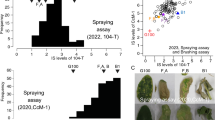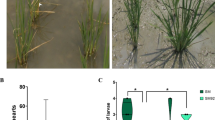Abstract
Soybean aphid (Aphis glycines Matsumura) results in severe yield loss of soybean in many soybean-growing countries of the world. A few loci have been previously identified to be associated with the aphid resistance in soybean. However, none of them was via isoflavone-mediated antibiosis process. The aim of the present study was to conduct genetic analysis of aphid resistance and to identify quantitative trait loci (QTL) underlying aphid resistance in a Chinese soybean cultivar with high isoflavone content. One hundred and thirty F5:6 derived recombinant inbred lines from the ‘Zhongdou 27’ × ‘Jiunong 20’ cross were used. Two QTL were directly associated with resistance to aphid as measured by aphid damage index. qRa_1, close to Satt470 on soybean linkage group (LG) A2 (chromosome 8), was consistently detected for 3- and 4-week ratings and explained a large portion of phenotypic variations ranging from 25 to 35%. qRa_2, close to Satt144 of LG F (chromosome 13), was detected for 3- and 4-week ratings and could explain 7 and 11% of the phenotypic variation, respectively. These two QTL were highly associated with high isoflavone content and both positive alleles were derived from ‘Zhongdou 27’, a cultivar with higher isoflavone content. The results revealed that higher individual or total isoflavones contents in soybean lines could protect soybean against aphid attack. These two QTL detected jointly provide potential for marker-assisted selection to improve the resistance of soybean cultivars to aphid along with the increase of isoflavone content.


Similar content being viewed by others
References
Boerma HR, Walker DR (2005) Discovery and utilization of QTLs for insect resistance in soybean. Genetica 123:181–189
Choi IY, Hyten DL, Matukumalli LK, Song Q, Chaky JM, Quigley CV, Chase K, Gorden Lark K, Reiter RS, Yoon MS, Wang EY, Yi SI, Yong ND, Shoemaker RC, van Tassell CP, Specht JE, Cregan PB (2007) A soybean transcript map: gene distribution, haplotype and single nucleotide polymorphism analysis. Genetics 176:685–696
Clark AJ, Perry KL (2002) Transmissibility of field isolates of soybean viruses by Aphis glycines. Plant Dis 86:1219–1222
Cregan PB, Jarvik T, Bush AL, Shoemaker RC, Lark KG, Kahler AL, Kaya N, VanToai TT, Lohnes DG, Chung J, Specht JE (1999) An integrated genetic linkage map of the soybean genome. Crop Sci 39:1464–1490
Davis JA, Radcliffe EB, Ragsdale DW (2005) Soybean aphid, Aphis glycines Matsumura, a new vector of potato virus Y in potato. Am J Potato Res 82:197–201
Fletcher MJ, Desborough P (2000) The soybean aphid, Aphis glycines, present in Australia. http://www.agric.nsw.gov.au/hort/ascu/insects/aglycin.htm
Graham MY, Graham TL (1991) Rapid accumulation of anionic peroxidases and phenolic polymers in soybean cotyledon tissues following treatment with Phytophthora megasperma f. sp. Glycinea wall glucan. Plant Physiol 97:1445–1455
Graham TL, Kim JE, Graham MY (1990) Role of constitutive isoflavone conjugates in the accumulation of glyceollin in soybean infected with Phytopthora megasperma. Mol Plant Microbe Interact 3:157–166
Hart SV, Kogan M, Paxton JD (1983) Effect of soybean phytoalexins on the herbivorous insects, Mexican bean beetle and soybean looper. J Chem Ecol 9:657–672
Hartman GL, Domier LL, Wax LM, Helm CG, Onstad DW, Shaw JT. Solter LF, Voegtlin DJ, D’Arcy CJ, Gray ME, SteVey KL, Isard SA, Orwick PL (2001) Occurrence and distribution of Aphis glycines on soybeans in Illinois in 2000 and its potential control. http://www.plantmanagementnetwork.org/pub/php/brief/aphisglycines/
Hill CB, Li Y, Hartman GL (2006a) A single dominant gene for resistance to the soybean aphid in the soybean cultivar Dowling. Crop Sci 46:1601–1605
Hill CB, Li Y, Hartman GL (2006b) Soybean aphid resistance in soybean Jackson is controlled by a single dominant gene. Crop Sci 46:1606–1608
Hoffmann-Campo CB, Harborne JB, McCaffery AR (2001) Pre-ingestive and post-ingestive effects of soya bean extracts and rutin on Trichoplusia ni growth. Entomol Exp Appl 98:181–194
Jiang ZF, Han YP, Teng WL, Zhang ZC, Sun DS, Li YH, Li WB (2010) Identification of QTL underlying the filling rate of protein at different developmental stages of soybean seed. Euphytica 175:227–236
Kang ST, Rouf Mian MA, Hammond RB (2008) Soybean aphid resistance in PI 243540 is controlled by a single dominant gene. Crop Sci 48:1744–1748
Kim KS, Hill CB, Hartman GL, Rouf Mian MA, Diers BW (2008) Discovery of soybean aphid biotypes. Crop Sci 48:923–928
Klingler J, Creasy R, Gao L, Nair RM, Calix AS, Jacob HS, Edwards OR, Singh KB (2005) Aphid resistance in Medicago truncatula involves antixenosis and phloem-specific, inducible antibiosis, and maps to a single locus flanked by NBS-LRR resistance gene analogs. Plant Physiol 137:1445–1455
Li SB, Zhang ZH, Hu Y, Li CY, Jiang X, Mao T, Li YS, Zhu YG (2006) Genetic dissection of developmental behavior of crop growth rate and its relationships with yield and yield related traits in rice. Plant Sci 170(5):911–917
Li Y, Hill CB, Carlson SR, Diers BW, Hartman GL (2007a) Soybean aphid resistance genes in the soybean cultivars Dowling and Jackson map to linkage group M. Mol Breed 19:25–34
Li YL, Niu SZ, Dong YB, Cui DQ, Wang YZ, Liu YY, Wei MG (2007b) Identification of trait-improving quantitative trait loci for grain yield components from a dent corn inbred line in an advanced backcross BC2F2 population and comparison with its F2:3 population in popcorn. Theor Appl Genet 115:129–140
Mensah C, DiFonzo C, Nelson RL, Wang D (2005) Resistance to soybean aphid in early maturing soybean germplasm. Crop Sci 45:2228–2233
Mensah C, DiFonzo C, Wang D (2008) Inheritance of soybean aphid resistance in PI 567541B and PI 567598B. Crop Sci 48:1759–1763
Mian R, Kang ST, Beil SE, Hammond RB (2008) Genetic linkage mapping of the soybean aphid resistance gene in PI 243540. Theor Appl Genet 117:955–962
Morris PF, Savard ME, Ward EWB (1991) Identification and accumulation of isoflavonoids and isoflavone glucosides in soybean leaves and hypocotyls in resistance responses to phytophthora megasperma f.sp. glycinea. Physiol Mol Plant Pathol 39:229–244
Ostlie K (2002) Managing soybean aphid, University of Minnesota Extension Service, St Paul. http://www.soybeans.umn.edu/crop/insects/aphid/aphid_publication_managingsba.htm
Painter RH (1951) Insect resistance in crop plants. Macmillan, New York
Piubelli GC, Hoffmann-Campo CB, de Arruda IC, Franchini JC, Lara FM (2003) Flavonoid increase in soybean as a response to Nezara viridula injury and its effect on insect-feeding preference. J Chem Ecol 29:1223–1233
Piubelli GC, Hoffmann-Campo CB, Moscardi F, Miyakubo SH, de Oliveira MC (2005) Are chemical compounds important for soybean resistance to Anticarsia gemmatalis? J Chem Ecol 31:1509–1524
Primomo VS, Poysa V, Ablett GR, Jackson CJ, Gijzen M, Rajcan I (2005) Mapping QTL for individual and total isoflavone content in soybean seeds. Crop Sci 45:2454–2464
Rao KV, Chattopadhyay SK, Chandrasekhara Reddy G (1990) Flavonoids with mosquito larval toxicity. J Agric Food Chem 38:1427–1430
Sharma HC, Norris DM (1991) Chemical basis of resistance in soy bean to cabbage looper, Trichoplusia ni. J Sci Food Agric 55:353–364
Song QJ, Marek LF, Shoemaker RC, Lark KG, Concibido VC, Delannay X, Specht JE, Cregan PB (2004) A new integrated genetic linkage map of the soybean. Theor Appl Genet 109:122–128
Stuber CW, Lincoln SE, Wolff DW, Helentjaris T, Lander ES (1992) Identification of genetic factors contributing to heterosis in a hybrid from two elite maize inbred lines using molecular markers. Genetics 132:832–839
Sun B, Liang SB, Zhao WX (2000) Outbreak of the soybean aphid in Suihua prefecture in 1998 and its control strategies. Soybean Bull 8:5
Wang XB, Fang CH, Zheng XP, Lin ZZ, Zhang LR, Wang HD (1994) A study on the damage and economic threshold of the soybean aphid at the seedling stage. Plant Prot 20:12–13
Wang RX, Hai L, Zhang XY, You GX, Yan CS, Xiao SH (2009) QTL mapping for grain filling rate and yield related traits in RILs of the Chinese winter wheat population Heshangmai 9 Yu8679. Theor Appl Genet 118:313–325
Wu Z, Schenk-Hamlin D, Zhan W, Ragsdale DW, Heimpel GE (2004) The soybean aphid in China: a historical review. Ann Entomol Soc Am 97:209–218
Zeng G, Li D, Han Y, Teng W, Wang J, Qiu L, Li W (2009) Identification of QTL underlying isoflavone contents in soybean seeds among multiple environments. Theor Appl Genet 118:1455–1463
Zhang G, Gu C, Wang D (2009) Molecular mapping of soybean aphid resistance genes in PI 567541B. Theor Appl Genet 118:473–482
Zhang G, Gu C, Wang D (2010) A novel locus for soybean aphid resistance. Theor Appl Genet 120:1183–1191
Zou JJ, Singh RJ, Lee J, Xu SJ, Cregan PB, Hymowitz T (2003) Assignment of molecular linkage groups to the soybean chromosomes by primary trisomics. Theor Appl Genet 107:745–750
Acknowledgments
This study was conducted in the Key Laboratory of Soybean Biology of Chinese Education Ministry and Soybean Development Centre of Agricultural Ministry, and financially supported by National High Technology Projects (2006AA10Z1F1 and 2006AA100104-4), National Nature Science Foundation Projects (60932008, 30971810), National 973 Project (2009CB118400) and Provincial Education Ministry for the Team of Soybean Molecular Design.
Author information
Authors and Affiliations
Corresponding author
Additional information
Communicated by I. Rajcan.
F. Meng and Y. Han contributed equally to this work.
Rights and permissions
About this article
Cite this article
Meng, F., Han, Y., Teng, W. et al. QTL underlying the resistance to soybean aphid (Aphis glycines Matsumura) through isoflavone-mediated antibiosis in soybean cultivar ‘Zhongdou 27’. Theor Appl Genet 123, 1459–1465 (2011). https://doi.org/10.1007/s00122-011-1680-y
Received:
Accepted:
Published:
Issue Date:
DOI: https://doi.org/10.1007/s00122-011-1680-y




